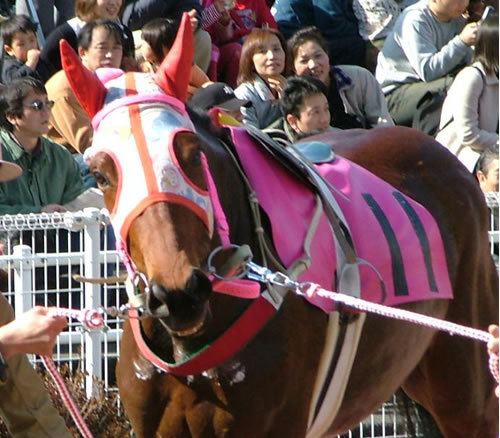Sire Nippo Teio Dam Heroine Foaled 27 February 1996 Species Equus caballus Trainer Dai Muneishi | Grandsire Lypheor Damsire Lucky Sovereign Country Japan Sex Mare Earnings 1.129 million JPY | |
 | ||
Mugen yahiro at haru urara grand festa 2016
Haru Urara (ハルウララ) is a Japanese racehorse. The horse gained nationwide popularity in 2003, not due to her success, but rather, due to a long string of consecutive losses.
Contents
Kagrra haru urara
Background
Haru Urara, a bay mare, was foaled on February 27, 1996, on Nobuta Bokujo, Utafue, Mitsuishi, Hokkaido. She was sired by Nippo Teio, a top-class racehorse whose wins included the Tenno Sho and the Yasuda Kinen. Unable to find a buyer for their filly, the farm began training Haru Urara as a racehorse, under their own ownership.
Racing career
At her debut, on November 17, 1998 at the Kōchi Racetrack, Haru Urara lost, placing fifth—and last. Over the next four-and-a-half years, she would compete once or twice every month, but was unable to obtain a single victory.
In June 2003, after garnering her 80th consecutive loss, the story was picked up by the national Japanese media, making "Haru Urara" a household name. She quickly became very popular in Japan, and was called "the shining star of losers everywhere" (負け組の星, makegumi no hoshi), for continuing to run with all her heart, despite her seemingly endless losing streak. This surge in popularity was dubbed "The Haru Urara Boom", and news about Haru Urara even reached the international community, being reported in the United States, Canada, Germany and elsewhere.
During the boom, Haru Urara betting tickets began to be used as o-mamori, particularly for protection against traffic accidents: the word "ataranai" (当たらない) in Japanese can mean both "to lose a bet" and "to avoid being struck", so it was said that a Haru Urara betting ticket—a guaranteed loss—could protect the owner's car from being hit. In September 2003, the Kōchi Prefecture Horse Racing Association introduced a service wherein they would stamp the word on any betting ticket related to Haru Urara. O-mamori were also created from mane and tail hairs that were said to have fallen out during brushing, but production was soon halted, due to concerns expressed by animal welfare groups.
At a race held on March 22, 2004, during the peak of her popularity, more than 13,000 spectators packed the Kochi Racetrack, 3,000 of whom had gathered outside before the gates opened, forcing the track to open 30 minutes earlier than scheduled. Some people waited in line for up to five hours to buy tickets at the "Haru Urara Commemorative Ticket Booth", which was established especially for the event. Fans bet a grand total of ¥121,751,200 on a Haru Urara victory, an impressive sum, particularly for a horse that had not won once in more than 100 attempts. The race ended in disappointment, but not surprise: despite being ridden by Japan's premier jockey, Yutaka Take, Haru Urara earned her 106th consecutive loss, placing 10th among 11 horses running.
Numerous products using Haru Urara's name or image have been produced, including stuffed toys, key rings, mobile phone straps, stickers, stamps, train tickets, rice, shochu, hats, T-shirts and bras. A number of books and songs, as well as a movie, were also written about Haru Urara during the boom period. The Japanese Prime Minister Junichiro Koizumi said "I'd like to see Haru Urara win, even just once. The horse is a good example of not giving up in the face of defeat."
Haru Urara has not yet been officially retired, but has not raced since September 2004. She currently maintains a record of 0 wins and 113 losses.
